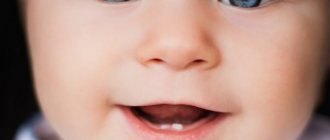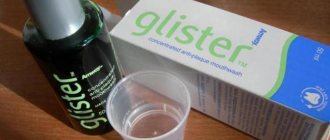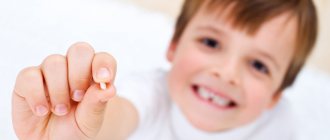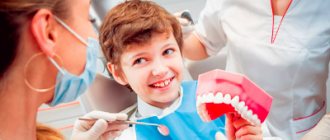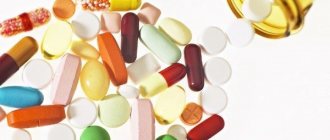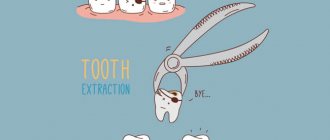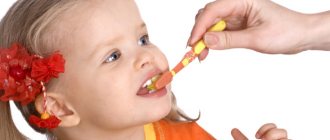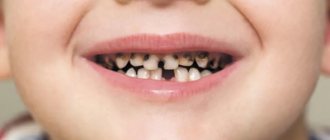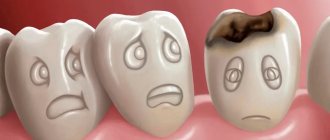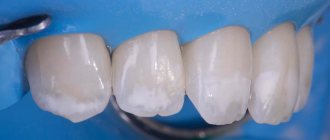The goal of oral hygiene in children is to remove soft plaque and carbohydrate food debris from the mucous membrane and dental surface. In childhood, another very important task is to accustom the baby to the need to invade such an area as the oral cavity. This habit will make it easier for you and your child to meet a specialist such as a dentist in the future.
A child should be taught oral hygiene from the moment he gets his first teeth - this way you can prevent tooth decay and take the first step to maintain dental health. At this age, it is not necessary to use a toothbrush; you can use a napkin (special, disposable, which can be bought at a pharmacy, or regular gauze), a cotton swab or a special silicone fingertip.
The procedure will need to be repeated after each feeding of the baby. This will help him gradually develop the skill of caring for his teeth. If your baby protests in every possible way when brushing his teeth, you should not be surprised, since he does not yet understand why such a procedure needs to be done. The thing is that children under 5-6 years old perceive the oral cavity as an intimate area, a source of pleasure. That is why, when any questionable or tasteless product enters the oral cavity, they reject it. It is important to teach your child to rinse his mouth with water and spit it out, and this can be done after each meal. This way the baby can learn to remove food debris from the mouth.
You need to accustom your baby to a toothbrush as soon as the chewing teeth and temporary molars erupt. Their chewing surface has a pronounced relief, which contributes to the accumulation of food debris between the chewing tubercles in the grooves. Removing them with a cotton swab or napkin is no longer possible. Since there is very thin enamel in the area of the intertubercular pits, caries most often begins there. Using a toothbrush, you need to carry out sweeping movements that are directed outward from the gingival edge of the tooth. The movements should be from the gum to the edge of the tooth. It is very important to thoroughly clean both the outer and inner tooth surfaces, making 3-5 sweeping movements from the inside and outside. To ensure that some teeth are not missed, brushing should be done in a circle, for example, starting from the upper right segment, then moving to the upper front and left segment, then to the lower segments - left and middle, and it is recommended to complete brushing in the area lower segment on the right. At first, it is recommended that children brush their teeth only with a toothbrush without using toothpaste, as they may swallow it. Or use special toothpastes that are safe to swallow. From the age of two, you can start using children's toothpaste, and its amount should not be more than 1 pea. Children under three years of age can only use toothpastes that do not contain fluoride. In children under 9-10 years of age, fine motor skills of the hands are most often not so developed that they can brush their teeth efficiently themselves. Therefore, the task of parents is to provide daily assistance in maintaining oral hygiene. Parents are responsible for the quality of teeth cleaning for children under 10 years of age!
You should definitely pay attention to the location of the teeth in the dentition - if they are located close to each other and form tight contacts with each other, then it is very difficult, and sometimes completely impossible, to penetrate such spaces with a toothbrush. Such areas can be cleaned using special threads - floss. With their help, it is possible to remove small fibrous food debris from the interdental spaces and thereby prevent the possibility of developing caries. It is advisable to use floss with a fibrous, soft structure - this will avoid possible involuntary injury to the gums. Interdental spaces can also be cleaned using special brushes.
You can improve your control of oral hygiene at any age with such an indispensable device as a plaque indicator. They come in liquid (ink-like liquid) and solid (chewable tablets). Liquid indicators are used by dentists, while tablets are more convenient for home use.
Such “magic” remedies have a very simple mechanism of action: using food coloring, they change the color of poorly visible, white plaque into a bright one. After staining, such plaque can simply be removed with ordinary hygiene products.
Why is child oral hygiene so important?
According to WHO (World Health Organization), 92% of people around the world brush their teeth incorrectly, therefore, adults also teach their children to brush their teeth incorrectly. Only a few people pay attention to the fact that the child’s oral cavity has significant differences from the adult’s oral cavity, which means that the hygiene of baby teeth is also different. Dentists advise paying attention to the structure of baby teeth, especially the first molars. The sixth teeth are more vulnerable than others. They erupt faster than others and often the distal tubercles are late freed from the “hood”, which serves as a place for plaque accumulation. In addition, it is in childhood that the probability of caries occurring is close to 100%. This is due to the inability of the child’s body to resist bacteria, the structure and vulnerable structure of the tooth itself, and other factors.
The best option for parents is to consult with a hygienist, who will show your child how to brush their teeth properly and tell you how often this should be done. There is one golden rule in oral hygiene that is relevant for both adults and children: after eating, brush your teeth. However, it is not always possible to follow it, especially when it comes to snacking on the go, at a party or in transport. At home, this rule must be followed strictly. The most important thing is not to forget about this important procedure and bring it to automaticity. What are the basic rules of children's hygiene?
How are the first teeth cut?
Teaching your child the rules of personal hygiene
Children are taught hygiene procedures from the first days of life. Find out how to teach your child to practice personal hygiene on his own.
The main symptoms of teething in infants are increased salivation and swelling of the gums.
The process is usually uncomfortable for the child and may be accompanied by increased moodiness and crying for no reason, insomnia and loss of appetite. A slight increase in temperature
(up to 38°C) may be a natural protective reaction of the body, but in this case the child should be shown to a doctor.
You can help the baby a little. Buy several teethers
- rubber or plastic toys for the child to bite on.
Chewing rings with liquid inside, which are first placed in the refrigerator to cool, has a particularly soothing effect. Additional methods
: Gently massage the baby's gums with a gauze pad soaked in cold water, or use baby teething gels with anesthetics, which the pediatrician will recommend.
Basic rules of oral hygiene for children
- You should brush your teeth at least twice a day with a special paste and a baby brush: after breakfast and before bed.
- Dental floss should become an indispensable aid in oral hygiene.
- In order to prevent the occurrence of bottle caries, it is best to minimize the number of snacks during the day, especially sweet ones.
- Every six months you should visit the dentist's office, if there are no problems with your teeth. If there are problems, visits to the doctor should occur more often.
Theodent Kids chocolate flavored theobromine toothpaste. Strengthens children's teeth and completely stops caries at an early stage.
The first months of life - taking care of your gums
In the first six months of life, the oral cavity is massively populated with microbes, which creates favorable conditions for the occurrence of caries, infantile thrush, stomatitis and other diseases. There are a lot of cases when microbes do not sleep, for example, when adults who are carriers of caries kiss a child, lick a pacifier, neglecting boiled water, and taste food with the spoon that will be fed to the baby. The risk of infection increases tenfold. To prevent something irreparable from happening, after each feeding the baby should wipe the gums with special fingertips or napkins with a weak soda solution.
Learning to brush baby teeth
Children who have already acquired teeth, with parental help, begin to brush their first baby teeth themselves using a special toothbrush for children. In this case, you need to start with 15-20 seconds for each cleaning, gradually increasing the duration. The main task of the mother at the stage of introducing the child to the brush is to awaken interest in a routine but necessary activity. There are at least two win-win ways:
- Teaching children oral hygiene goes a long way if parents offer the child a game. Having heard how the kind toothbrush aunt cleans her teeth one after another, making them beautiful and driving out harmful microbes, most kids will willingly open their mouths and patiently wait for the process to end.
- Another effective training method is to do as mom does. Often, children copy their parents' behavior, speech and facial expressions. In the same way, they learn how to brush their teeth properly. By doing daily brushing with your baby, and at the same time helping him, you will make sure that after some time the child will reach for the toothbrush on his own. The main thing is that the child likes the taste of the toothpaste!
Of course, there are often cases when there is neither toothpaste nor brush at hand - sweet snacks on the street, at a party or in transport. In this situation, many dentists recommend using sugar-free chewing gum, thereby restoring the alkaline balance. However, the process of chewing it should not exceed 10 - 15 minutes.
The Curababy “girl set” CKC 42 CURAPROX is made of durable materials and is completely safe, since it does not contain any dyes or other harmful components.
What foods are good for your first teeth?
Foods rich in calcium
.
First of all, it is cottage cheese and hard cheese. Slightly less calcium is found in milk, fermented milk products, green leafy vegetables, gooseberries, currants, and cherries. Sources of vitamin D, without which calcium cannot be absorbed, are egg yolk and butter. You should include carbohydrate foods in your child’s diet less often: bread, potatoes, and especially sugar and sweet foods. Sweets provoke the active proliferation of bacteria in the mouth, which leads to early caries
. “The longer you don’t offer your child sweets, the better,” says Kuznetsova, “for example, children under three years old should not be given chocolate at all.”
Oral hygiene products for children
Necessary items for children's oral hygiene are a toothbrush and toothpaste. A children's toothbrush should be chosen with soft and relatively short bristles of 2 cm, a small narrow head with two rows of tufts and a long handle. For an older child who begins to brush his teeth himself, a brush with a short handle, but at the same time voluminous, is best suited to simplify the procedure. The dosage of the paste should not exceed the size of the nail on the child’s little finger. The baby will be more willing to brush his teeth with a special children's toothpaste with a pleasant taste and aroma. The main thing is to make sure that the child does not get carried away and eat the toothpaste, otherwise this can lead to damage to the mucous membrane, allergies, and in some cases, dysbacteriosis.
There are also wipes for oral hygiene. They are intended for children who are too early to use toothbrushes and toothpastes. These wipes are an excellent way to clean your baby's teeth and gums. The wipes contain xylitol, which inhibits the growth and reproduction of bacteria that cause caries. They are also indispensable during teething. It is advisable to store them in the refrigerator, as cool wipes will help alleviate pain in the baby’s gums. In addition, they will subsequently help accustom the child to future daily hygiene procedures.
Another essential hygiene item is dental floss. Help your child remove plaque between the teeth and in the gum area by flossing to prevent tartar buildup.
Three differences between children's toothpaste and adult toothpaste
- The requirements for the recipe, that is, for the composition of the tube itself, are the most important difference. We are talking about low abrasiveness of children's pastes: they should either not contain fluoride at all, or contain it in minimal quantities; often hygiene products for babies contain additional enzymes that soften plaque until it is completely dissolved; But it is better to refuse toothpastes with whitening particles and wait until you are 12 years old - at a tender age they will do more harm than good.
- Taste and aroma, as a rule, with the addition of fruit, chocolate and other flavor enhancers. According to statistics, about 30–35% of children swallow the tasty toothpaste when brushing. For this reason, dentists recommend using pastes with neutral scents to avoid excesses.
- The colorfulness of the tube and its design.
Ultra-soft bristles, made using a unique patented technology, of the DBB - 1Y Hapica electric brush do not damage the thin enamel of baby teeth and the baby’s delicate gums. Using a brush does not require effort, but at the same time makes brushing your teeth as effective as possible.
Features of jaw development at 8–13 years of age. Changeable bite
The main thing that happens to a child’s teeth at this age is that they change to permanent ones. This condition of the jaw in adolescents is called a mixed bite.
By the age of 3, the child has 20 temporary teeth, which began to grow from the age of six months. They are gradually replaced by indigenous ones (with normal development, complete replacement occurs by 13–14 years). 8–12 chewing teeth also appear, which immediately erupt as permanent teeth.
During the period of change of occlusion, the roots of baby teeth dissolve, preparing the place for new, permanent teeth. The change in bite begins at the age of 6 and lasts for the next 8. The sequence of teeth change is the same for all children, but the boundaries of the periods may vary. The front milk teeth are the first to be renewed - just remember the photographs of first-graders on school rulers! At this time, children's jaws are actively growing, and gaps appear between the teeth necessary to freely accommodate molars - they are always larger than baby teeth. Constant changes in the structure of the jaw will occur in a child up to 14 years of age.
The formation of a bite is a very long and important process, on which the health and appearance of the child in the future largely depends. Therefore, it is necessary that from 6 to 14 years of age he undergoes an annual examination by an orthodontist. The doctor will ensure that the teeth are correctly positioned in the dental arch, and will also monitor their size, shape, and enamel characteristics. It is much easier to track bite deviations in childhood or adolescence than to correct them when the child grows up.
Professional oral hygiene in children
Professional hygiene is usually understood as a set of procedures, the purpose of which is to improve the health of the tissues and organs of the oral cavity and prevent the occurrence of dental ailments. This includes removing soft and hard plaque from teeth, closing fissures, that is, dental dimples, making them less vulnerable, as well as covering the dental surface with a special varnish. The dentist's office is not as treacherous as it looks at first glance. In addition to the preventive procedure, the doctor can conduct an oral hygiene lesson, select a toothpaste and brush for the child based on the individual characteristics of the oral cavity structure, and also give useful and competent care tips.
Finally, I would like to once again draw attention to the fact that caring for a child’s teeth requires special attention due to the subsequent formation of “lifelong” teeth. After all, as healthy as baby teeth are, the molars will be as strong!
Rules for choosing toothpaste
If the brush cleans all dirt mechanically, then the functions of toothpaste are much broader. Many people prefer universal options, which, according to the manufacturer, do everything at once; clean, whiten, freshen breath, treat and prevent various diseases. As a rule, such pastes are not medicinal and actually partially solve all of the above problems. Universal toothpastes are safe and suitable for people without serious dental problems.
